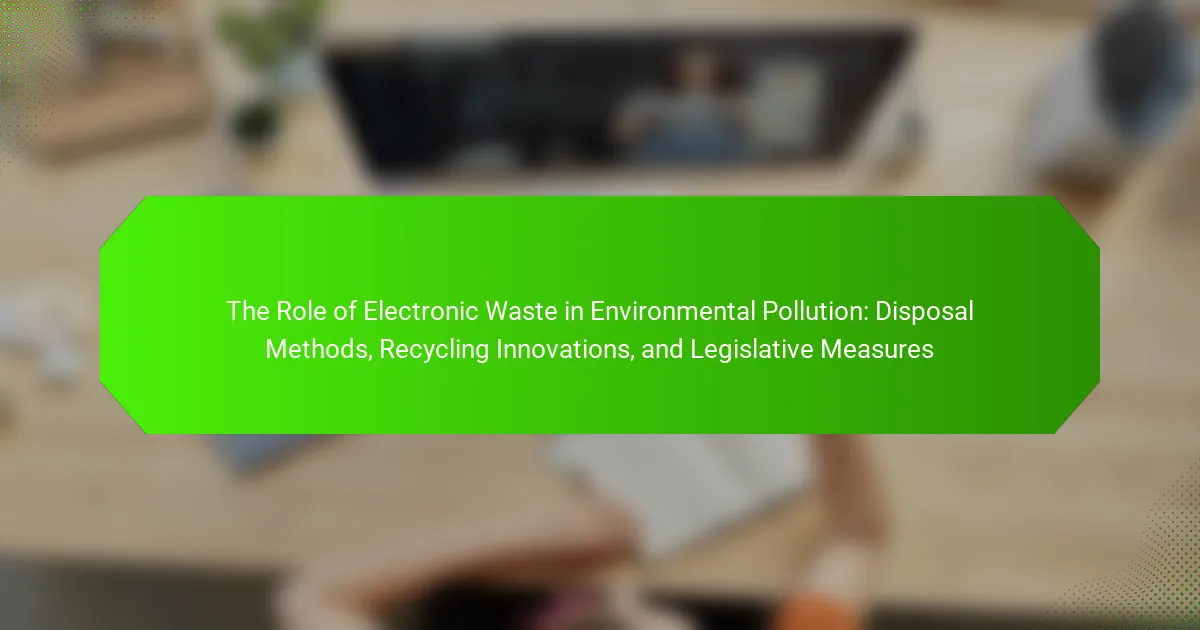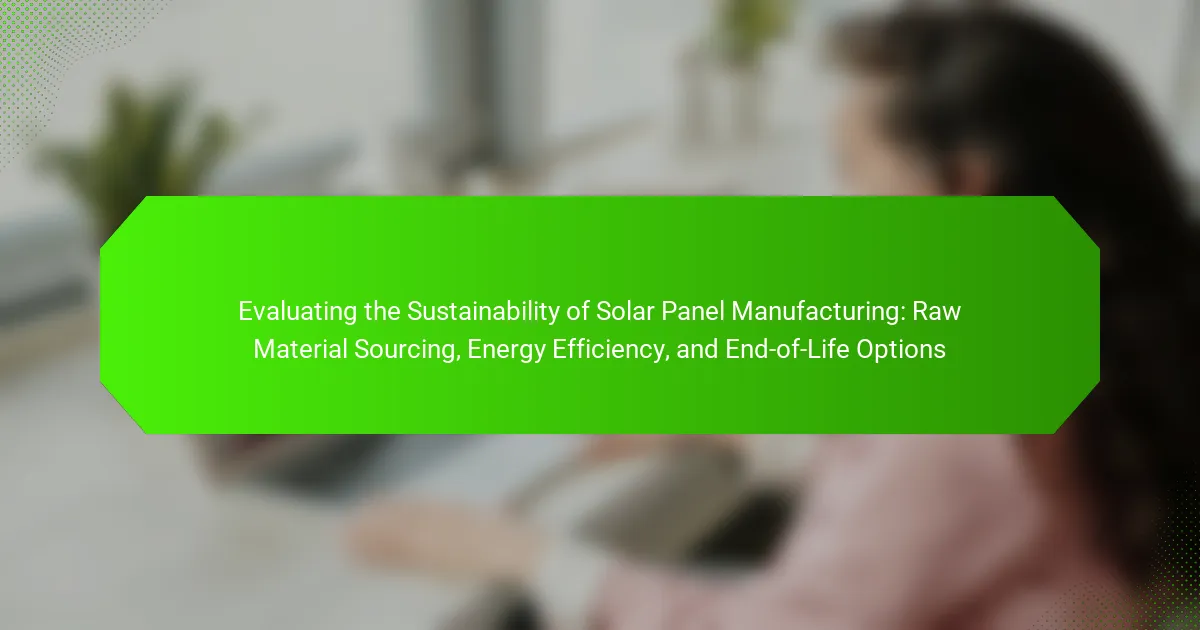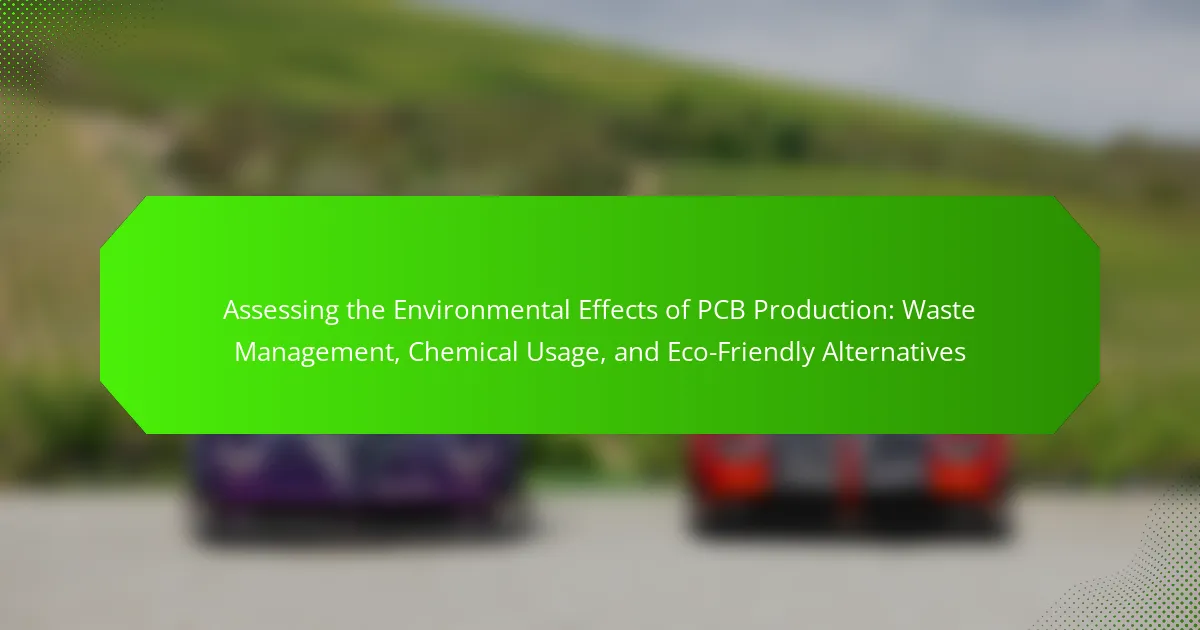Electronic waste, commonly known as e-waste, encompasses discarded electronic devices such as computers, smartphones, and televisions, which often contain hazardous materials like lead, mercury, and cadmium. The article examines the significant environmental pollution and health risks associated with improper disposal of e-waste, highlighting that only 17.4% of the 53.6 million metric tons generated in 2019 was recycled properly. It discusses various disposal methods, including recycling, donation, and landfill disposal, and emphasizes the importance of innovative recycling technologies and modular design in reducing e-waste’s environmental impact. Additionally, the article outlines key legislative measures, such as the Basel Convention and the European Union’s WEEE Directive, aimed at promoting sustainable e-waste management practices.
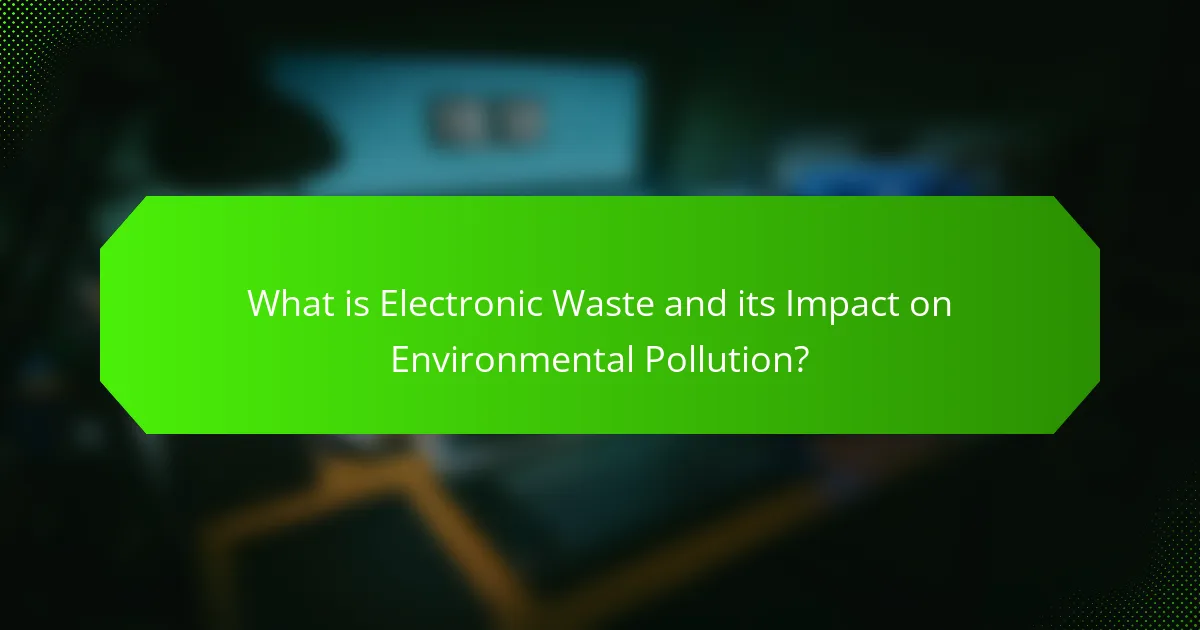
What is Electronic Waste and its Impact on Environmental Pollution?
Electronic waste, or e-waste, refers to discarded electronic devices and components. This includes items like computers, smartphones, and televisions. E-waste contains hazardous materials such as lead, mercury, and cadmium. When improperly disposed of, these substances can leach into soil and water. This leads to significant environmental pollution and health risks. According to the Global E-waste Monitor 2020, approximately 53.6 million metric tons of e-waste were generated worldwide in 2019. Only 17.4% of this was recycled properly. The improper handling of e-waste contributes to air and water contamination, affecting ecosystems and human health.
How does electronic waste contribute to environmental pollution?
Electronic waste contributes to environmental pollution primarily through the release of toxic substances. When e-waste is improperly disposed of, hazardous materials like lead, mercury, and cadmium leach into the soil and water. These substances can contaminate local ecosystems and harm wildlife. Additionally, burning e-waste releases harmful chemicals into the air. A study by the United Nations University estimates that 50 million tons of e-waste are generated annually, with only 20% being recycled properly. This improper recycling exacerbates pollution issues. Furthermore, the accumulation of e-waste in landfills leads to long-term environmental degradation.
What are the primary pollutants found in electronic waste?
The primary pollutants found in electronic waste include heavy metals, flame retardants, and polychlorinated biphenyls (PCBs). Heavy metals such as lead, mercury, and cadmium are commonly present. These substances can leach into the environment and pose significant health risks. Flame retardants, often found in circuit boards and plastic casings, can release toxic compounds when disposed of improperly. PCBs, used in older electronic devices, are harmful and can persist in the environment for long periods. Studies indicate that improper disposal of electronic waste can lead to soil and water contamination, affecting ecosystems and human health.
How do these pollutants affect ecosystems and human health?
Electronic waste pollutants adversely affect ecosystems and human health. Heavy metals like lead and mercury leach into soil and water, disrupting local flora and fauna. These metals accumulate in the food chain, harming wildlife and reducing biodiversity. For humans, exposure to these toxins can lead to serious health issues. Studies indicate that lead exposure is linked to neurological damage and developmental disorders in children. Mercury can cause cognitive impairments and damage to the kidneys and nervous system. Additionally, chemicals from e-waste can contaminate drinking water sources, posing risks to community health. Proper disposal and recycling methods can mitigate these harmful effects.
What are the global statistics on electronic waste generation?
In 2021, global electronic waste generation reached 57.4 million metric tons. This figure represents a 9.2% increase compared to 2019. The United Nations estimated that by 2030, e-waste could surpass 74 million metric tons annually. Only 17.4% of e-waste was formally collected and recycled in 2019. The remaining waste often ends up in landfills or is informally processed. High-income countries generate more e-waste per capita than low-income countries. For instance, Europe produced 16.2 kg per inhabitant in 2019. In contrast, Africa generated only 1.9 kg per inhabitant. These statistics highlight the growing challenge of managing electronic waste globally.
Which countries produce the most electronic waste?
China, the United States, and India produce the most electronic waste. In 2019, China generated approximately 10.1 million metric tons of e-waste. The United States followed closely with around 6.9 million metric tons. India ranked third, producing about 3.2 million metric tons. These countries’ high production rates stem from large populations and significant technology consumption. According to the Global E-Waste Monitor 2020, global e-waste reached 53.6 million metric tons in 2019. This increasing trend poses serious environmental challenges.
How has electronic waste generation changed over the years?
Electronic waste generation has increased significantly over the years. In 2019, the global electronic waste reached 53.6 million metric tons. This figure represents a 21% increase from 2014. The rise is attributed to the rapid technological advancements and increased consumption of electronic devices. According to the Global E-waste Monitor 2020, only 17.4% of e-waste was formally recycled in 2019. The rest ended up in landfills or informal recycling operations. Projections indicate that electronic waste could exceed 74 million metric tons by 2030. This trend highlights the urgent need for improved recycling and disposal methods.
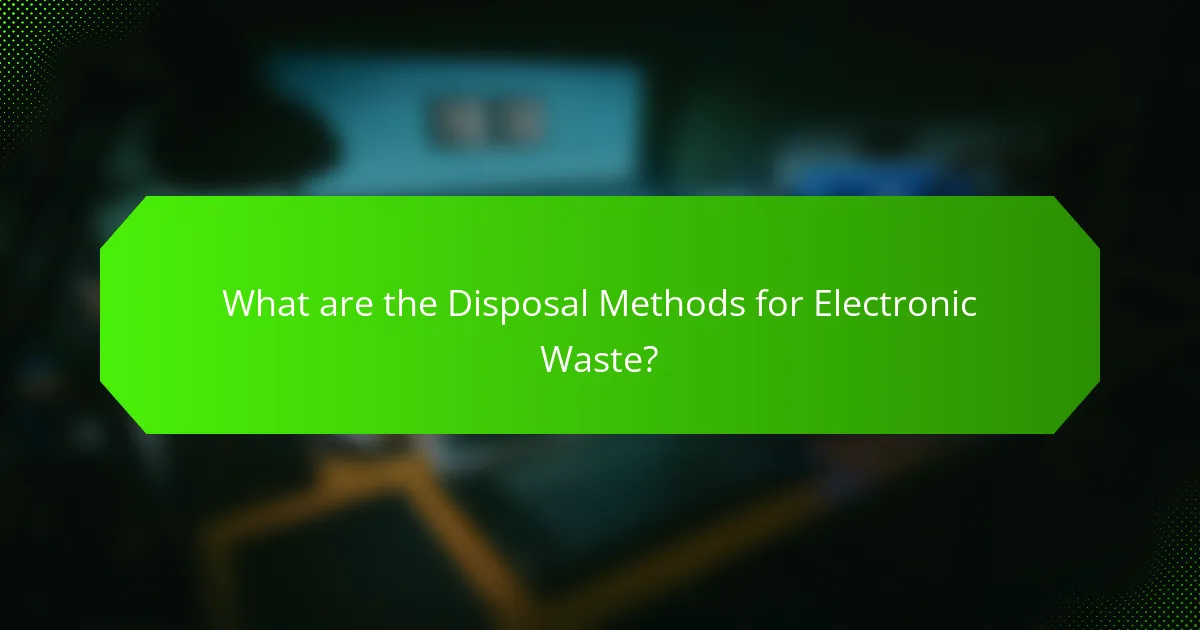
What are the Disposal Methods for Electronic Waste?
The disposal methods for electronic waste include recycling, donation, and landfill disposal. Recycling involves processing electronic components to recover valuable materials. This method reduces landfill waste and conserves resources. Donation allows functional devices to be reused by others, extending their life cycle. Landfill disposal is often the least preferred option due to environmental concerns. Proper disposal is crucial as electronic waste contains hazardous substances. These substances can leach into the environment if not managed correctly. Statistics show that improper disposal contributes significantly to environmental pollution.
What are the common disposal methods for electronic waste?
Common disposal methods for electronic waste include recycling, landfilling, and incineration. Recycling involves processing electronic devices to recover valuable materials. This method reduces the need for new raw materials and minimizes environmental impact. Landfilling is the disposal of electronic waste in designated sites. It can lead to soil and water contamination due to toxic substances in devices. Incineration involves burning electronic waste, which can generate energy but releases harmful emissions. According to the Global E-Waste Monitor 2020, only 17.4% of e-waste was recycled properly in 2019. This highlights the need for improved disposal practices.
How do landfill disposal and incineration differ in their environmental impact?
Landfill disposal and incineration differ significantly in their environmental impact. Landfills primarily contribute to soil and groundwater contamination through leachate, which can contain harmful chemicals. According to the Environmental Protection Agency, leachate can lead to severe ecological damage if not managed properly. Incineration, on the other hand, reduces waste volume and generates energy but emits greenhouse gases and toxic pollutants, including dioxins. The World Health Organization has linked these emissions to various health risks. While landfills can take decades to decompose waste, incineration can process waste quickly, though at the cost of air quality. Each method presents unique challenges in waste management and environmental protection.
What challenges are associated with improper disposal of electronic waste?
Improper disposal of electronic waste poses significant environmental and health challenges. Toxic substances in e-waste, such as lead and mercury, can leach into soil and water. This contamination can harm ecosystems and disrupt local wildlife. Additionally, improper disposal can lead to air pollution from burning e-waste, releasing harmful chemicals. The World Health Organization estimates that millions of people are exposed to hazardous substances from e-waste. Furthermore, improper disposal can result in lost economic opportunities from recycling valuable materials. The global e-waste volume reached 53.6 million metric tons in 2019, highlighting the urgency of addressing these challenges.
How effective are current disposal methods in mitigating pollution?
Current disposal methods for electronic waste are moderately effective in mitigating pollution. Methods like recycling, incineration, and landfilling each have their strengths and weaknesses. Recycling can recover valuable materials and reduce landfill waste. However, improper recycling practices can lead to toxic emissions and environmental damage. Incineration reduces volume but may release harmful pollutants if not properly managed. Landfilling can lead to leachate and groundwater contamination if not designed correctly. According to a study by the United Nations University, only 17.4% of e-waste was formally recycled in 2019. This indicates a significant gap in effectiveness. Improved regulations and public awareness are crucial for enhancing disposal methods and reducing pollution.
What are the limitations of existing disposal methods?
Existing disposal methods for electronic waste have several limitations. Many methods do not effectively recover valuable materials. Incineration can release toxic emissions into the atmosphere. Landfilling leads to soil and water contamination from leachate. Some methods fail to address hazardous components like heavy metals. Additionally, there is often a lack of proper recycling facilities. The infrastructure for e-waste disposal is insufficient in many regions. Public awareness about proper disposal is generally low. These factors contribute to the growing environmental pollution from electronic waste.
How can disposal methods be improved to reduce environmental impact?
Disposal methods can be improved to reduce environmental impact by implementing more effective recycling processes. Enhanced recycling can recover valuable materials from electronic waste, minimizing landfill contributions. For instance, studies show that recycling can recover up to 90% of precious metals from e-waste. Additionally, developing eco-friendly disposal technologies reduces harmful emissions during processing. Legislative measures can enforce stricter regulations on e-waste disposal, promoting responsible practices. Education and awareness campaigns can inform consumers about proper disposal methods. These strategies collectively contribute to a significant reduction in the environmental footprint of electronic waste disposal.
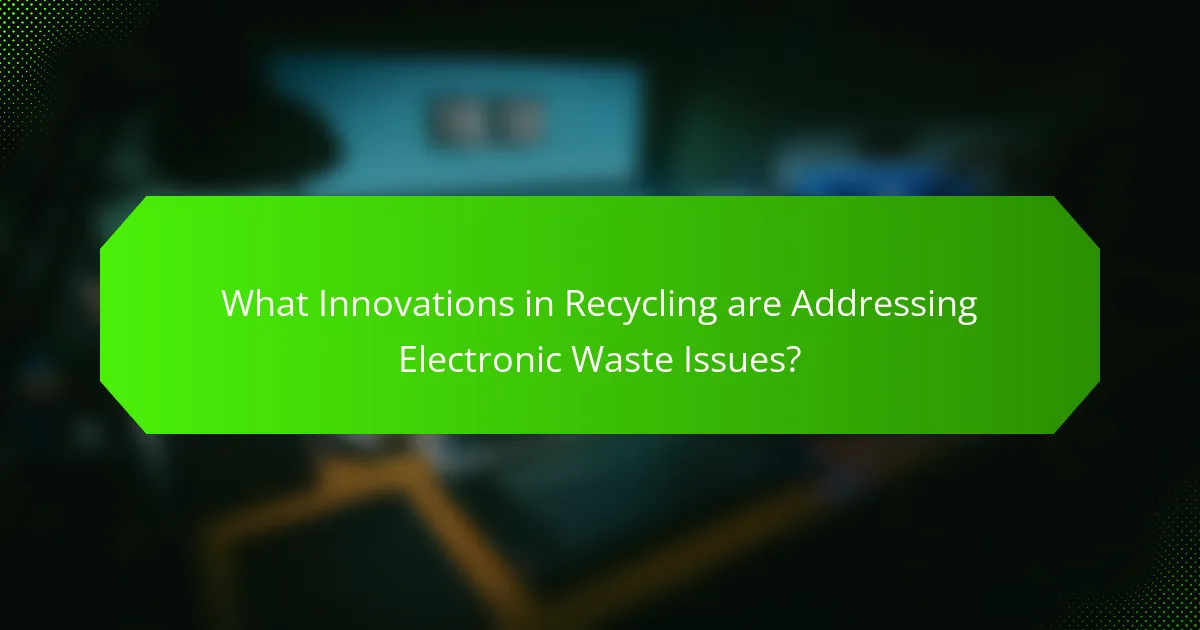
What Innovations in Recycling are Addressing Electronic Waste Issues?
Innovations in recycling addressing electronic waste issues include advanced sorting technologies and hydrometallurgical processes. Advanced sorting technologies use artificial intelligence to identify and separate different materials in e-waste efficiently. This increases the recovery rates of valuable metals like gold and silver. Hydrometallurgical processes involve using environmentally friendly solvents to extract metals from electronic components. This method reduces the need for harmful chemicals typically used in traditional recycling.
Additionally, modular design in electronics promotes easier disassembly and recycling. Manufacturers are focusing on creating products that can be easily taken apart to recover materials. Programs for take-back and recycling incentives encourage consumers to return old devices. These initiatives help reduce e-waste entering landfills.
Research shows that these innovations can significantly lower the environmental impact of electronic waste. According to the Global E-Waste Monitor 2020, only 17.4% of e-waste was recycled in 2019. Improvements in recycling technologies could increase this percentage substantially.
What are the latest innovations in electronic waste recycling?
The latest innovations in electronic waste recycling include advanced techniques such as hydrometallurgical processes and automated sorting technologies. Hydrometallurgical processes use environmentally friendly solvents to extract precious metals from electronic components. This method minimizes harmful waste and increases recovery rates. Automated sorting technologies utilize AI and robotics to efficiently separate different materials in e-waste. This enhances the accuracy and speed of recycling operations. Additionally, there are innovations in biorecycling, which employ microorganisms to break down complex materials. These advancements contribute to more sustainable recycling practices and reduce the environmental impact of electronic waste.
How do these innovations enhance the recycling process?
Innovations enhance the recycling process by increasing efficiency and reducing contamination. Advanced sorting technologies, such as AI and machine learning, accurately identify materials. This precision minimizes the mixing of recyclables, leading to higher quality outputs. Automated processes speed up the handling of electronic waste. This reduces labor costs and human error. Innovations also include improved shredding techniques, which allow for better separation of materials. Enhanced recycling methods can recover up to 90% of valuable metals from e-waste. These advancements ultimately support a more sustainable recycling ecosystem.
What role does technology play in improving recycling efficiency?
Technology significantly enhances recycling efficiency by automating sorting processes. Advanced machines utilize artificial intelligence to identify and separate materials more accurately. This reduces contamination rates in recycling streams. Automated systems can process larger volumes of waste in shorter timeframes. For instance, optical sorters can distinguish between different types of plastics rapidly. Additionally, data analytics improve logistics and operational efficiencies in recycling facilities. According to a study by the World Economic Forum, implementing technology can increase recycling rates by up to 30%. This demonstrates the essential role of technology in optimizing recycling operations.
What are the environmental benefits of recycling electronic waste?
Recycling electronic waste reduces environmental pollution. It prevents hazardous materials like lead and mercury from contaminating soil and water. Proper recycling recovers valuable materials such as gold, silver, and copper. These materials can be reused, reducing the need for mining. Mining has significant environmental impacts, including habitat destruction and water pollution. According to the United Nations, recycling e-waste can recover up to 90% of materials. This process conserves natural resources and reduces greenhouse gas emissions. Overall, recycling electronic waste contributes to a more sustainable environment.
How does recycling reduce the need for raw materials?
Recycling reduces the need for raw materials by reprocessing existing materials into new products. This process conserves natural resources and minimizes environmental impact. For example, recycling aluminum saves 95% of the energy required to produce new aluminum from bauxite ore. Similarly, recycling paper reduces the need for logging and the associated deforestation. According to the Environmental Protection Agency, recycling and composting prevented the release of 186 million metric tons of carbon dioxide equivalent into the air in 2013. Thus, recycling effectively decreases reliance on extracting and processing raw materials.
What impact does recycling have on reducing pollution levels?
Recycling significantly reduces pollution levels. It minimizes the need for raw material extraction, which often generates harmful emissions. For example, recycling paper can reduce air pollution by up to 74%. Additionally, recycling electronics prevents toxic substances from entering landfills. This process decreases soil and water contamination. According to the Environmental Protection Agency, recycling and composting prevented the release of approximately 186 million metric tons of carbon dioxide equivalent into the air in 2013. Thus, effective recycling practices contribute to lower pollution levels and promote environmental sustainability.
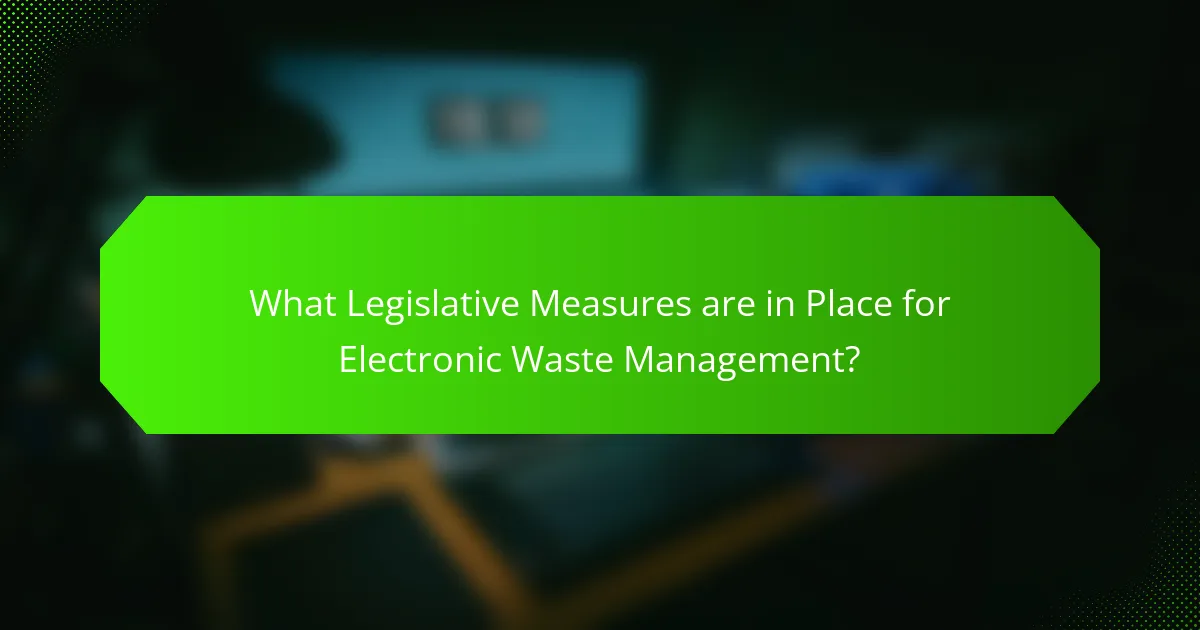
What Legislative Measures are in Place for Electronic Waste Management?
Various legislative measures are in place for electronic waste management. The Basel Convention regulates international trade and disposal of hazardous waste, including e-waste. The European Union’s Waste Electrical and Electronic Equipment (WEEE) Directive mandates proper recycling and disposal of electronic products. In the United States, the Resource Conservation and Recovery Act (RCRA) governs hazardous waste management, impacting e-waste. Additionally, state-level laws, such as California’s Electronic Waste Recycling Act, set specific collection and recycling requirements. These measures aim to reduce environmental pollution and promote sustainable e-waste management practices.
What are the key legislative measures addressing electronic waste?
Key legislative measures addressing electronic waste include the Waste Electrical and Electronic Equipment (WEEE) Directive in the European Union. This directive mandates the collection, recycling, and recovery of electronic waste. It aims to reduce the environmental impact of discarded electronics. The directive requires manufacturers to take responsibility for the entire lifecycle of their products. In the United States, the Responsible Electronics Recycling Act promotes safe recycling practices. It prohibits the export of hazardous electronic waste to developing countries. Additionally, various states have enacted their own e-waste laws. For example, California’s Electronic Waste Recycling Act establishes a funding system for e-waste recycling programs. These legislative measures collectively aim to manage electronic waste effectively and minimize its environmental impact.
How do these regulations vary across different regions?
Regulations concerning electronic waste vary significantly across different regions. In the European Union, the Waste Electrical and Electronic Equipment (WEEE) Directive mandates strict recycling targets and producer responsibility. In contrast, the United States lacks a federal electronic waste regulation, leading to state-level differences in disposal practices. For example, California has stringent e-waste laws, while other states may have minimal regulations. In Asia, countries like Japan have comprehensive recycling laws, while others struggle with enforcement. This disparity can lead to varying environmental impacts and recycling rates in each region.
What penalties exist for non-compliance with electronic waste legislation?
Penalties for non-compliance with electronic waste legislation can include significant fines. These fines can range from hundreds to thousands of dollars, depending on the severity of the violation. In some jurisdictions, repeated offenses may lead to increased penalties. Additionally, companies may face legal action, including lawsuits from affected parties. Non-compliance can also result in the suspension or revocation of business licenses. Some regions impose criminal charges for severe violations, which can lead to imprisonment. These measures aim to enforce compliance and protect the environment from hazardous waste.
How effective are these legislative measures in reducing electronic waste pollution?
Legislative measures are effective in reducing electronic waste pollution. Regulations such as the Waste Electrical and Electronic Equipment (WEEE) Directive in the European Union mandate proper disposal and recycling of e-waste. These laws have led to increased collection rates of e-waste, with over 10 million tons collected annually in Europe. Additionally, studies show that compliance with e-waste regulations can result in a 30% reduction in hazardous waste. Countries with strict e-waste laws, like Switzerland, report recycling rates exceeding 80%. Overall, legislative measures play a crucial role in mitigating the environmental impact of electronic waste.
What are the success stories of effective electronic waste legislation?
Germany’s WEEE Directive has significantly reduced electronic waste. Since its implementation in 2005, Germany has achieved a collection rate of 65% for e-waste. This legislation mandates manufacturers to take responsibility for the entire lifecycle of their products. It encourages recycling and proper disposal methods.
In Switzerland, the Swiss Federal Law on the Disposal of Electrical and Electronic Equipment has been successful. This law has led to a recycling rate of over 75% for e-waste. The country established a system where consumers can return their old electronics for free.
In the United States, California’s Electronic Waste Recycling Act has made a notable impact. Since its enactment in 2003, California has collected over 1 billion pounds of e-waste. The law imposes a recycling fee on new electronics to fund recycling programs.
These examples demonstrate the effectiveness of electronic waste legislation in promoting responsible disposal and recycling practices.
What challenges do governments face in enforcing electronic waste laws?
Governments face significant challenges in enforcing electronic waste laws. One major challenge is the rapid growth of electronic waste, which outpaces regulatory frameworks. The global electronic waste generation reached 53.6 million metric tons in 2019, according to the Global E-waste Monitor. Additionally, the informal sector plays a large role in e-waste recycling. Many individuals operate outside of legal frameworks, making enforcement difficult.
Lack of public awareness also hampers enforcement efforts. Many consumers are unaware of proper disposal methods for electronic products. Furthermore, limited resources and funding for monitoring and enforcement create obstacles. Governments often struggle to allocate sufficient personnel and financial support to tackle e-waste issues effectively.
Lastly, international trade complicates enforcement. E-waste is often exported to developing countries, where regulations may be less stringent. This creates challenges for governments attempting to manage e-waste within their jurisdictions.
What best practices can individuals and businesses adopt for responsible electronic waste management?
Individuals and businesses can adopt several best practices for responsible electronic waste management. First, they should prioritize recycling by using certified e-waste recycling facilities. These facilities ensure that materials are processed safely and sustainably. Second, they can donate functioning electronics to charities or schools. This extends the life of devices and reduces waste. Third, they should implement take-back programs. Many manufacturers offer programs to return old devices for proper recycling. Fourth, they can educate employees and the community about e-waste issues. Awareness fosters responsible disposal behaviors. Lastly, they should keep records of e-waste disposal. Documentation helps track compliance with regulations and sustainability goals. According to the Global E-waste Monitor 2020, only 17.4% of e-waste was formally collected and recycled in 2019. This highlights the importance of adopting responsible practices to improve e-waste management.
Electronic waste (e-waste) refers to discarded electronic devices and components, which contain hazardous materials that can significantly impact environmental pollution and human health. This article examines the environmental consequences of e-waste, including the release of toxic substances and the challenges associated with improper disposal methods. It also explores innovations in recycling technologies, legislative measures for e-waste management, and best practices for individuals and businesses to adopt responsible e-waste disposal. Key statistics highlight the growing volume of e-waste and the urgent need for effective recycling and disposal strategies to mitigate its environmental impact.
